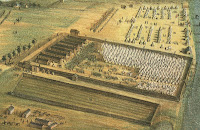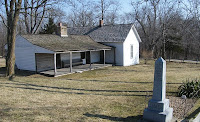The Point Lookout Lighthouse
located at the southern tip of Point Lookout in Scotland, Maryland is
considered a hot spot of paranormal activity.
Because of treacherous storms in the area, many shipwrecks occurred in the years before 1827.
Congress finally took note and ordered a small beacon light be built to protect passing ships. This lighthouse was completed in 1830. It originally had one and a half stories.
Because of treacherous storms in the area, many shipwrecks occurred in the years before 1827.
Congress finally took note and ordered a small beacon light be built to protect passing ships. This lighthouse was completed in 1830. It originally had one and a half stories.
After the Civil War, this
lighthouse was expanded when a fog bell tower was built, and porches were added
on the front and back of the building. In 1888 water erosion threatened the
lighthouse. A wood and steel bulwark was constructed to protect its cement
foundation.
Today the building is much closer to the shoreline because of this continued erosion. By 1930, the lighthouse was enlarged to its present size. Hot and cold running water was installed, and the house was split into two apartments.
Today the building is much closer to the shoreline because of this continued erosion. By 1930, the lighthouse was enlarged to its present size. Hot and cold running water was installed, and the house was split into two apartments.
In 1939 the station was
transferred to the United States Coast Guard. But civilian keepers remained to
maintain the light. In 1965, an offshore steel tower replaced the Point Lookout
Lighthouse. The state of Maryland leased the buildings to the Navy in 2002, but
by 2006 the state of Maryland took control.
Today the Point Lookout Preservation Society holds occasional open houses during the day. This society allows paranormal groups in to do investigations of the lighthouse for a nominal $50.00 fee. This is a good idea--other preservation societies should take note.
Today the Point Lookout Preservation Society holds occasional open houses during the day. This society allows paranormal groups in to do investigations of the lighthouse for a nominal $50.00 fee. This is a good idea--other preservation societies should take note.
The first lighthouse keeper
to be assigned to Point Lookout in the early 1830s died within months of arriving.
His daughter Ann Davis took over his duties. She remained the keeper until her
death in the lantern room while performing her daily tasks. It is said she
haunts this building.
A famous photograph was taken that shows her ghost standing at the head of the stairs wearing a white blouse and light blue skirt.
A famous photograph was taken that shows her ghost standing at the head of the stairs wearing a white blouse and light blue skirt.
Many of the ghostly sightings
at the lighthouse are that of Confederate and Union soldiers. The reason for
this is because a Civil War prison camp and hospital were near the
tower.
One witness, Gerald Sword stayed by himself in the lighthouse in 1970. He heard doors being slammed closed, moans, and the sound of men snoring, as well as objects crashing to the floor. When he inspected the area, nothing was amiss. He also felt cold spots.
One witness, Gerald Sword stayed by himself in the lighthouse in 1970. He heard doors being slammed closed, moans, and the sound of men snoring, as well as objects crashing to the floor. When he inspected the area, nothing was amiss. He also felt cold spots.
Many witnesses have seen a
Union soldier guarding the steps of the light.
Laura Berg--the Secretary of State for Maryland in the 1980s lived in the Point Lookout Lighthouse with her husband in the 1970s.
One night while lying in bed, she heard footsteps outside her bedroom door. They were heavy as if the person were wearing boots. This sound ended as mysteriously as it began. The couple continued to hear footsteps in the hall at night.
Laura Berg--the Secretary of State for Maryland in the 1980s lived in the Point Lookout Lighthouse with her husband in the 1970s.
One night while lying in bed, she heard footsteps outside her bedroom door. They were heavy as if the person were wearing boots. This sound ended as mysteriously as it began. The couple continued to hear footsteps in the hall at night.
The Bergs also heard other
noises. They often awoke to strange smells in the house.
One night Berg awakened to see six strange lights over her head. She bolted upright and smelled the odor of smoke coming from the first floor. She ran downstairs and discovered the heater had caught fire. The flames were extinguished quickly. Berg feels that it was the ghosts that alerted her to this danger.
One night Berg awakened to see six strange lights over her head. She bolted upright and smelled the odor of smoke coming from the first floor. She ran downstairs and discovered the heater had caught fire. The flames were extinguished quickly. Berg feels that it was the ghosts that alerted her to this danger.
Nancy Stallings, a medium with
the Maryland Committee for Psychical Research, is standing in the middle of one
of the lighthouse’s’ bedrooms above. A soldier appears in the photo to the
right of Nancy. This soldier was not seen by any of the participants.
Many EVP’s have been recorded
in this lighthouse over the years. One group picked up 24 distinct voices
recorded in various places around the house. An EVP captured a voice
stating: “Fire if they get too close to
you.“ It is believed this is the voice of a Union soldier guarding the
prisoners in the camp.
Another EVP picked up in the lighthouse basement is that of shutters slamming in the wind. There was no wind the day this was recorded, and the shutters had been removed years before.
Another EVP picked up in the lighthouse basement is that of shutters slamming in the wind. There was no wind the day this was recorded, and the shutters had been removed years before.
Here is a must see link that has many EVP’s that have been recorded at Point Lookout Lighthouse. Just click
on the word or words in the boxes under the “Sound” category, and they will take
you to the recording. The second one, entitled “drums” is impressive.
The following is a link to The Ghosts of Point Lookout Part l where I share stories about ghosts from a Civil War hospital and Confederate prisoner of war camp.
The following is a link to The Ghosts of Point Lookout Part l where I share stories about ghosts from a Civil War hospital and Confederate prisoner of war camp.


























